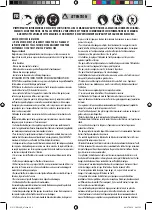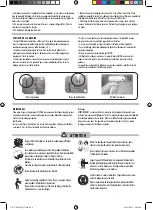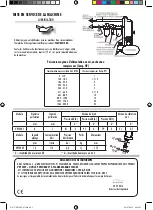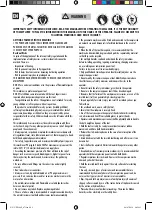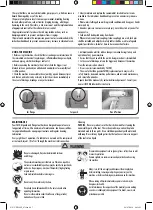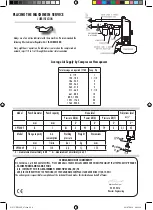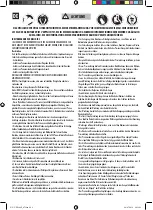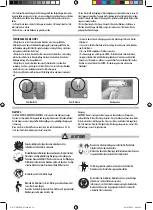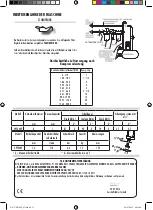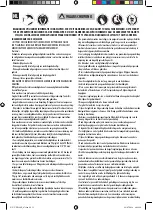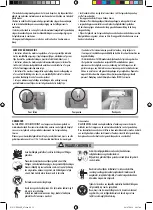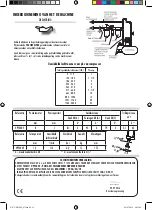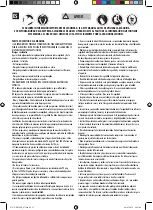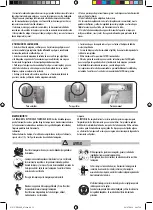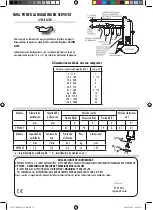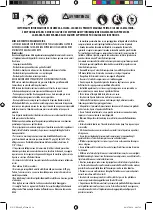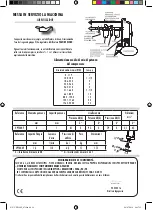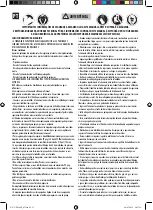
EN
WARNING
IMPORTANT SAFETY INFORMATION ENCLOSED. READ THIS MANUAL BEFORE OPERATING THE MACHINE. IT IS THE RESPONSIBILITY
OF THE EMPLOYER TO PLACE THE INFORMATION IN THIS MANUAL INTO THE HANDS OF THE OPERATOR. FAILURE TO OBSERVE THE
FOLLOWING WARNINGS COULD RESULT IN INJURY.
GETTING STARTED WITH THE MACHINE
• THE PUNCH AND FLANGE TOOL IS INTENDED FOR FLANGING AND
PUNCHING OF SHEET METAL. FACOM WILL NOT BE LIABLE IF THE MACHINE
IS USED FOR ANY OTHER PURPOSE.
Residual Risks
In spite of the application of the relevant safety regulation and the
implementation of safety devices, certain residual risks cannot be
avoided. These are:
- Impairment of hearing.
- Risk of personal injury due to flying particles.
- Risk of burns due to accessories becoming hot during operation.
- Risk of personal injury due to prolonged use.
THIS MACHINE HAS NOT BEEN DESIGNED TO BE USED IN AN EXPLOSIVE
ATMOSPHERE.
DO NOT use under wet conditions or in the presence of flammable liquids
or gases.
This machine is a professional power tool.
DO NOT let children come into contact with the tool. Supervision is
required when inexperienced operators use this tool.
- Young children and the infirm. This appliance is not intended for use by
young children or infirm persons without supervision.
- This product is not intended for use by persons (including children)
suffering from diminished physical, sensory or mental abilities; lack of
experience, knowledge or skills unless they are supervised by person
responsible for their safety. Children should never be left alone whith this
product.
This machine and its accessories must be used in compliance with these
instructions. Using it for any other purpose may cause a risk of danger for
people and the environment.
• Always operate, inspect and maintain this machine in accordance with
all regulations (local, state, federal and country), that may apply to hand
held/hand operated pneumatic machine.
• For safety, top performance, and maximum durability of parts, operate
this machine at 90 psig (6.2 bar/620 kPa) maximum air pressure at the
inlet with 3/8” (10 mm) inside diameter air supply hose.
• Exceeding the maximum pressure of 6.2 bar will lead to the risk of
danger such as excessive speed, breaking parts, higher torque or force
that may destroy the machine and its accessories or the part being
worked on.
• Be sure all hoses and fittings are the correct size and are tightly
secured.
• Don’t abuse hoses or connectors.
• Always use clean, dry and lubricated air at 90 psig maximum air
pressure. Dust, corrosive fumes and/or excessive moisture can ruin the
motor of an air machine.
• Do not lubricate machine with flammable or volatile liquids such as
kerosene, diesel or petrol.
• Do not remove any labels. Replace any damaged label.
• The use of a hose whip is recommended. A coupler connected directly to
the air inlet increases tool bulk and decreases tool maneuverability.
• The pneumatic machine must be fitted and connected to the compressed
air network via quick disconnects to facilitate shutdown in the event of
danger.
• When the life of the tool has expired, it is recommended that the
machine be disassembled, degreased and parts be separated by material
so that they can be recycled.
• For multiple hazards, read and understand the safety instructions
before installing, operating, repairing, maintaining, changing accessories
on, or working near compression power tool.
Failure to do so can result in serious bodily injury.
• Only qualified and trained operators should install, adjust or use the
compression power tool.
• Do not modify this compression power tool. Modifications can reduce
the effectiveness of safety measures and increase the risks to the
operator.
• Do not discard the safety instructions; give them to the operator.
• Do not use the compression power tool if it has been damaged.
• Be aware that the failure of the workpiece or accessories, or even of the
inserted tool itself, can generate high-velocity projectiles.
• lnspect regularly for cracks; injury can result if a cracked yoke or jaw
fails with use.
• For overhead work, wear a safety helmet.
• Ensure that the workpiece is securely fixed.
• Use of the tool can expose the operator’s hands to hazards including
cuts, abrasions and heat. Wear suitable gloves to protect hands.
• Operators and maintenance personnel shall be physically able to handle
the bulk, weight and power of the tool.
• Hold the tool correctly; be ready to counteract normal or sudden
movements and have both hands available.
• Release the start-and-stop device in the case of an interruption of the
energy supply.
• Avoid direct contact with the inserted tool during and after use as it can
become hot.
• Tools shall not be operated if directed toward the operator or any other
person.
• Keep hands away from compression mechanism; it is recommended that
operators hold the compression power tool with both hands.
• Regular inspections for cracks and fissures in the compression mecha-
nism and yoke shall be made.
• Hold the inserted tool firmly against the work surface before starting
the tool.
• Use only sizes and types of accessories and consumables that are
recommended by the manufacturer of the compression power tools; do
not use other types or sizes of accessories or consumables.
• Slips, trips and falls are major causes of workplace injury. Be aware of
slippery surfaces caused by use of the tool and also of trip hazards caused
by the air line or hydraulic hose.
• Proceed with care in unfamiliar surroundings. There can be hidden
hazards, such as electricity or other utility lines.
NU-V.PF300F_0716.indd 6
08/07/2016 08:26:11
Summary of Contents for V.PF300F
Page 49: ...FACOM 1 2 1 3 FACOM FACOM FACOM NU V PF300F_0716 indd 49 08 07 2016 08 28 01...
Page 54: ...RU FACOM 6 2 620 10 6 2 6 2 NU V PF300F_0716 indd 54 08 07 2016 08 28 06...
Page 55: ...FACOM 1 2 1c 3 FACOM FACOM FACOM C NU V PF300F_0716 indd 55 08 07 2016 08 28 08...
Page 61: ...NOTA NU V PF300F_0716 indd 61 08 07 2016 08 28 19...



